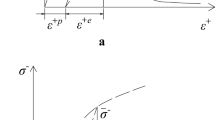Abstract
This paper presents a method for the calibration of parameters of coupled damage-plasticity models for concrete. The determination procedure uses the experimental fact that during the fracture process in concrete in tension a considerable part of energy dissipation occurs via a plastic frictional mechanism hitherto disregarded in many constitutive models. The procedure developed provides a consistent and rational way of determining the parameters for coupled damage-plasticity models of concrete. We highlight the advantages of the thermodynamic approach that serves as the basis for the constitutive model used here, and give a simple one-dimensional example as an illustration of the calibration process.
Similar content being viewed by others
References
Z.P. Bazant (1996) ArticleTitleAnalysis of work-of-fracture method for measuring fracture energy of concrete ASCE ASCE J. Engrg. Mech. 122 IssueID2 138–144 Occurrence Handle10.1061/(ASCE)0733-9399(1996)122:2(138)
Z.P. Bazant (2002) ArticleTitleConcrete fracture models: testing and practice Engrg. Fract. Mech. 69 165–205 Occurrence Handle10.1016/S0013-7944(01)00084-4
W.F. Chen J. Han D. (1988) Plasticity for structural engineers Springer-Verlag Newyork Inc Occurrence Handle0666.73010
C. Comi U. Perego (2001) ArticleTitleFracture energy based bi-dissipative damage model for concrete Int. J. Solids Struct. 38 6427–6454 Occurrence Handle0996.74069 Occurrence Handle10.1016/S0020-7683(01)00066-X
M. Elices G.V. Guinea J. Gomez J. Planas (2002) ArticleTitleThe cohesive zone model: advantages, limitations and challenges Engrg. Fract. Mech. 69 137–163 Occurrence Handle10.1016/S0013-7944(01)00083-2
G.T. Houlsby A.M. Puzrin (2000) ArticleTitleA thermomechanical framework for constitutive models for rate-independent dissipative materials Int. J. Plasticity. 16 1017–1047 Occurrence Handle0958.74011 Occurrence Handle10.1016/S0749-6419(99)00073-X
A.D. Jefferson (2003) ArticleTitleCraft - a plastic-damage-contact model for concrete. I. Model theory and thermodynamic considerations Int. J. Solids Struct. 40 5973–5999 Occurrence Handle1059.74545 Occurrence Handle10.1016/S0020-7683(03)00390-1
Jirásek, M., and Patzák B. (2001). Models for quasibrittle failure: Theoretical and computational aspects, ECCM-2001 European Conference on Computational Mechanics, June 26-29, 2001, Cracow, Poland
C Le Bellego JF Dube G Pijaudier-Cabot B. Gerard (2003) ArticleTitleCalibration of nonlocal damage model from size effect tests Eur. J. Mech. A/Solids. 22 33–46 Occurrence Handle1018.74526 Occurrence Handle10.1016/S0997-7538(02)01255-X
J. Lemaitre (1992) A course on damage mechanics Springer Verlag Berlin Occurrence Handle0756.73002
B. Luccioni S. Oller R. Danesi (1996) ArticleTitleCoupled plastic-damaged model Comput. Methods Appl. Mech. Engrg. 129 81–89 Occurrence Handle0860.73047 Occurrence Handle10.1016/0045-7825(95)00887-X
G. Meschke R. Lackner H.A. Mang (1998) ArticleTitleAn anisotropic elastoplastic-damage model for plain concrete Int. J. Numer. Meth. Engng. 42 703–727 Occurrence Handle0908.73062 Occurrence Handle10.1002/(SICI)1097-0207(19980630)42:4<703::AID-NME384>3.0.CO;2-B
Nguyen, G.D. (2005). A thermodynamic approach to constitutive modelling of concrete using damage mechanics and plasticity theory, D.Phil. Thesis, Dept. of Engrg. Science, Oxford University.
P.C. Perdikaris A. Romeo (1995) ArticleTitleSize effect on fracture energy of concrete and stability issues in three-point bending fracture toughness testing ACI Materials Journal. 92 IssueID5 483–496
H. Reinhardt H.A.W. Cornelissen D.A. Hordjil (1986) ArticleTitleTensile tests and failure analysis of concrete ASCE J. Struct. Engrg. 112 IssueID11 2462–2477 Occurrence Handle10.1061/(ASCE)0733-9445(1986)112:11(2462)
M.R. Salari S. Saeb K.J. Willam S.J. Patchet R.C. Carrasco (2004) ArticleTitleA coupled elastoplastic damage model for geomaterials Comput. Methods Appl. Mech. Engrg. 193 IssueID27-29 2625–2643 Occurrence Handle1067.74567 Occurrence Handle10.1016/j.cma.2003.11.013
F. Tin-loi N.S. Que (2001) ArticleTitleParameter identification of quasibrittle materials as a mathematical program with equilibrium constraints Comput. Methods Appl. Mech. Engrg. 190 5819–5836 Occurrence Handle1002.74039 Occurrence Handle10.1016/S0045-7825(01)00199-2
S. Yazdani H.L. Schreyer (1990) ArticleTitleCombined plasticity and damage mechanics model for plain concrete ASCE J.Engrg. Mech. 116 IssueID7 1435–1450
Author information
Authors and Affiliations
Corresponding author
Rights and permissions
About this article
Cite this article
Nguyen, G.D., Korsunsky, A.M. Damage-Plasticity Modelling of Concrete: Calibration of Parameters using Separation of Fracture Energy. Int J Fract 139, 325–332 (2006). https://doi.org/10.1007/s10704-006-8379-0
Issue Date:
DOI: https://doi.org/10.1007/s10704-006-8379-0




